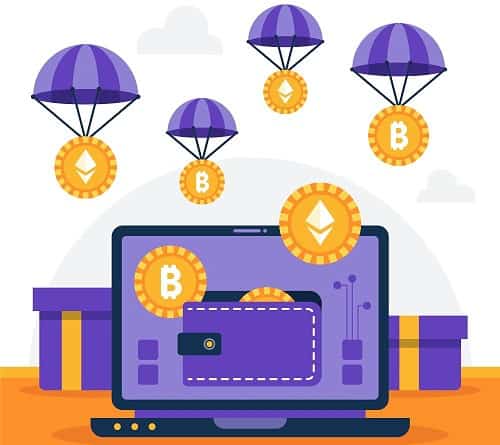Crypto Airdrops: Everything You Need to Know and More
I. Introduction to Airdrops
Hey there, curious minds! Let’s embark on a journey into the enigmatic world of crypto airdrops, where free tokens rain down from the blockchain heavens. But first, what exactly are airdrops? They’re not parcels falling from the sky, but in the realm of cryptocurrencies, they’re close.
Airdrops are like surprise gifts, where crypto projects distribute tokens to a community of users for various reasons.
Airdrops started as a humble concept and blossomed into a significant phenomenon within the crypto space. We’ll take a peek into their evolution and unravel their pivotal role in shaping the crypto ecosystem.
II. Reasons Behind Airdrops
Ever wondered why crypto projects toss free tokens your way? It’s not just generosity; it’s strategic. Airdrops are part of savvy marketing campaigns, a way to give birth to new tokens, and a secret sauce for fostering vibrant communities. Let’s delve deeper into the motives behind this crypto generosity.
1. Marketing and Promotion
Goal: Generating Buzz and Awareness
Airdrops are a powerful marketing tool. They create a buzz around a project or a new cryptocurrency by distributing tokens widely. When a project airdrops tokens, it attracts attention from existing crypto enthusiasts and newcomers alike. This strategy creates an initial user base and helps in word-of-mouth promotion as recipients often discuss the project within their circles.
2. Distribution of New Tokens
Goal: Widening Token Holder Base
For new projects or cryptocurrencies, airdrops facilitate the initial distribution of tokens. By giving away tokens for free, these projects can quickly reach a larger audience. This widens the holder base, potentially creating a more decentralized ownership structure right from the start. It also allows projects to get their tokens into the hands of users who may become active participants in the ecosystem.
3. Building and Engaging Communities
Goal: Fostering Active Participation
Airdrops serve as an incentive for community engagement. Projects aim to reward users who actively participate in discussions, contribute to the project’s growth, or engage in community-building activities. By rewarding community involvement with tokens, projects encourage users to become more involved in the project’s success, creating a dedicated and loyal user base.
4. Creating Value and Interest
Goal: Generating Interest and Value Perception
The act of receiving free tokens can create perceived value. Even if the tokens have little immediate value, airdrops spark interest and curiosity among users. This perception can lead recipients to explore and potentially invest more time and resources in understanding and utilizing the tokens they’ve received, thus driving the token’s value over time.
5. Compliance and Token Distribution
Goal: Complying with Regulations and Achieving Wider Distribution
In some cases, airdrops are used as a compliant way to distribute tokens. Projects might use airdrops to comply with regulatory requirements, ensuring wider token distribution without directly selling or trading the tokens, which might fall under specific regulatory restrictions.
6. Encouraging Adoption and Use Cases
Goal: Encouraging Adoption and Utility
Airdrops can encourage the adoption of a new technology or platform by incentivizing users to test or use the tokens within the project’s ecosystem. By distributing tokens for free, projects aim to encourage initial usage, which, if successful, can lead to broader adoption and utilization of the tokens.
Overall, airdrops serve as a multifaceted tool that goes beyond simply giving away tokens. They are strategic maneuvers designed to attract attention, build communities, distribute tokens, and spark interest and engagement within the crypto landscape.
III. How Airdrops Work
Airdrops operate like a digital treasure hunt, offering various ways to earn tokens – from holding specific cryptocurrencies to engaging in community events or supporting projects early on. These airdrops come in different types: token, fork, exchange, and community-driven campaigns. However, not everyone can access this digital wealth. We’ll delve into what determines who gets these rewards and who misses out.
In exploring how airdrops function, it’s crucial to understand their mechanics, aims, and the diverse types they encompass.
Types of Airdrops
- Token Airdrops
- Function: Distribute new tokens to holders of a specific cryptocurrency.
- How They Work: Holders of a certain cryptocurrency (like Bitcoin or Ethereum) receive a proportionate amount of a new token as a reward or incentive for holding the original cryptocurrency. This type aims to introduce and promote the new token to an existing user base.
- Fork Airdrops
- Function: Occur during a blockchain fork, where a new cryptocurrency splits from an existing one.
- How They Work: When a blockchain undergoes a fork, existing holders of the original cryptocurrency might automatically receive an equal amount of the new cryptocurrency. This happens when the new cryptocurrency shares the transaction history of the original blockchain up to a specific block, effectively splitting into two chains.
- Exchange Airdrops
- Function: Conducted by cryptocurrency exchanges to reward users or attract new ones.
- How They Work: Exchanges might offer tokens to users for activities like signing up, completing KYC (Know Your Customer) procedures, making trades, or fulfilling specific criteria set by the exchange. These airdrops aim to incentivize users to use the exchange’s services and increase user engagement.
- Community Airdrops
- Function: Target specific communities or user groups for engagement.
- How They Work: Projects conduct community airdrops to reward active community members, contributors, or supporters. These airdrops often require users to participate in discussions, social media activities, or other community-related tasks to receive tokens. They aim to foster engagement and loyalty within the project’s community.

How Airdrops Function
- Selection Criteria
Determining Eligibility: Projects set specific criteria for eligibility. This might include holding a minimum amount of a particular cryptocurrency, being an active participant in a community, or meeting other specified conditions.
- Snapshot
Capturing Blockchain Data: Projects often take a snapshot of the blockchain at a specific block height or date to identify eligible wallets. Holders of the specified cryptocurrency in those wallets at the time of the snapshot are considered eligible for the airdrop.
- Token Distribution
Allocating Tokens: Once eligibility is established, tokens are distributed to the eligible wallets. This distribution can occur immediately after the snapshot or at a later time, and the method can vary depending on the project. Some may distribute tokens directly to wallets, while others might require users to claim their tokens through a specific process.
Airdrops, regardless of their type, rely on predetermined criteria, blockchain snapshots, and token distribution mechanisms to reward eligible users with free tokens. These mechanisms aim to incentivize participation, reward engagement, and promote the adoption of new tokens or projects within the crypto community.
IV. Participating in Airdrops
Now, the million-dollar question: how can you claim these freebies? Fear not, intrepid reader, for we’ve got a roadmap! From setting up the right wallets to safeguarding your digital assets, and tips on making the most of airdrop opportunities, we’ll guide you through the process.
Participating in airdrops involves a few steps to ensure eligibility and readiness to receive the free tokens. Here’s a detailed guide on how to participate:
1. Prepare and Research:
- Understand Requirements: Learn about the specific criteria set by the project for eligibility. This could include holding a certain cryptocurrency, joining a community, or fulfilling other conditions.
- Identify Airdrop Opportunities: Research upcoming airdrops through cryptocurrency forums, social media, airdrop aggregator websites, or official project announcements. Platforms like Airdrop Alert, Airdropster, or CoinMarketCap often list ongoing and upcoming airdrops.
2. Wallet Preparation:
- Select Compatible Wallets: Ensure you have a compatible wallet that supports the airdropped tokens. Wallets can be hardware, software, or mobile-based. Examples include MetaMask, Trust Wallet, MyEtherWallet, Ledger Nano, etc.
- Secure Your Wallet: Prioritize security by using reputable wallets and safeguarding your private keys. Beware of scams or phishing attempts requesting your private keys or sensitive information.
3. Meeting Eligibility Criteria:
- Hold the Required Cryptocurrency: If the airdrop requires holding a specific cryptocurrency in your wallet, ensure you have the requisite amount before the snapshot date.
- Participate in Community Activities: Engage with the project’s community or social media channels if community engagement is part of the eligibility criteria. Join discussions, follow official accounts, or participate in promotional activities.
4. Claiming Airdropped Tokens:
- Follow Project Instructions: Keep an eye on official project announcements or communication channels for instructions on claiming the airdropped tokens. Projects might provide specific steps or links to claim tokens.
- Verify Legitimacy: Ensure that the airdrop announcement or instructions come from the official project channels to avoid falling prey to scams or fraudulent attempts.
5. Maximizing Airdrop Benefits:
- Participate Wisely: Be selective about the airdrops you participate in. Focus on projects that have a credible background, strong community support, and potential for future growth.
- Stay Informed: Continuously monitor updates from the project to stay informed about any changes, token distribution timelines, or additional requirements.
6. After Receiving Tokens:
- Track Token Value: Keep an eye on the value of the airdropped tokens in the market. Some airdropped tokens might have immediate value, while others might take time to gain value or utility.
- Explore Utility: Research the use cases and potential utility of the tokens. Some projects might have specific functions or purposes within their ecosystems.
By following these steps, individuals can effectively participate in airdrops, increasing their chances of receiving free tokens and potentially benefiting from their future value or utility within the cryptocurrency ecosystem.
V. Evaluating Airdrops
Not all that glitters is gold, and not all airdrops are worth your attention. We’ll equip you with the tools to separate the gems from the gravel, ensuring you don’t fall into any crypto pitfalls. It’s all about assessing legitimacy, understanding token potential, and being wary of potential risks.
Red Flags in Airdrop Scams
- Requests for Private Keys or Personal Information
- Legitimate airdrops don’t ask for your secret keys or sensitive data. Scammers exploit this info for all sorts of mischief.
- Unsolicited Airdrop Messages
- If you receive random messages or emails hyping up airdrops, be cautious. Scammers often use these tactics to bait unsuspecting victims.
- Too Good to Be True Promises
- Beware of airdrops promising massive token rewards without clear explanations. If it sounds too amazing, it might just be a scam in disguise.
- Transparency Issues
- Projects without clear roadmaps or team details across different platforms might be hiding something. Legitimate ones are upfront about their plans and team.
- Urgent Calls to Action
- Scammers love urgency. If you’re pressured to act immediately, take a step back. Legit airdrops won’t force you into rushed decisions.
Signs of Potential Airdrop Scams
- Counterfeit Projects
- Scammers create fake projects mimicking real ones. They’re masters at copying logos, names, and websites to seem legit.
- Impersonating the Good Guys
- Scammers pretend to be reputable projects, claiming to run an airdrop. Always verify details through official sources to avoid getting tricked.
- Phishing Links or Malware
- Sketchy links from airdrop ads might lead to fishy websites. Watch out for phishing attempts or sites loaded with malware looking to grab your info.
- Outlandish Requirements
- Scammers ask for too much—like loads of personal info, payments, or unrelated tasks. Legit projects keep it simple and relevant.
Protecting Yourself from Airdrop Scams
- Source Verification
- Double-check from official project sites, social accounts, or trustworthy crypto hubs. Don’t click links from unsolicited emails—it’s like opening a mystery box.
- Thorough Investigation
- Dive deep into project details, team backgrounds, and community chatter. Consistency is key—shady stuff usually comes with inconsistency.
- Reliable Platforms
- Trust well-known platforms for airdrop info. They have a reputation to maintain and usually steer clear of scammy stuff.
- Stay in the Know
- Keep up with crypto forums or communities to learn from others’ experiences. Being informed is your best armor against scams.
Spotting the warning signs, doing your homework, and staying alert can keep you safe from airdrop scams. Protect yourself, your assets, and your peace of mind by being a savvy crypto user.
VI. Notable Airdrop Case Studies
Prepare to be inspired! We’ll shine a spotlight on some standout airdrop campaigns that made waves in the crypto ocean. These stories are more than just success tales; they’re valuable lessons on how airdrops can shape the destiny of projects and communities.
1. Ethereum (ETH) – The Genesis of Airdrops:
- Case Overview: Ethereum’s airdrop of ETH in 2014 stands as one of the earliest and most influential in crypto history.
- Airdrop Impact: Ethereum distributed ETH to early supporters, raising awareness and incentivizing participation in its ICO. The airdrop played a crucial role in Ethereum’s initial community building and the subsequent rise of decentralized applications (dApps) on its network.
2. Uniswap (UNI) – A Game-Changing Governance Airdrop:
- Case Overview: Uniswap surprised its users in 2020 with a governance token airdrop (UNI) to past users of the platform.
- Airdrop Impact: UNI tokens were distributed to historical users, including liquidity providers and traders. This move not only rewarded early adopters but also granted them governance rights in the Uniswap protocol, showcasing the power of community-driven governance in DeFi.
VII. Regulatory Considerations
Ah, the legal labyrinth. We’ll navigate through the maze of regulations, exploring the legal implications and challenges that airdrops face in various corners of the globe. After all, legality matters, even in the wild west of crypto.
Regulatory considerations surrounding crypto airdrops have gained significance as the crypto space evolves and authorities aim to define and enforce regulations. Here are key aspects of regulatory considerations in crypto airdrops:
1. Legal Classification
- Unclear Regulatory Framework: Many jurisdictions lack specific guidelines addressing airdrops, leading to ambiguity in their legal classification. Airdrops might fall under different regulatory categories based on their purpose and the tokens’ nature.
- Securities Regulation: Depending on the tokens’ characteristics, airdropped tokens might be deemed securities, subject to regulations like the Howey Test in the United States. Compliance with securities laws might be necessary to avoid legal complications.
2. AML/KYC Compliance
- Anti-Money Laundering (AML) and Know Your Customer (KYC): Airdrops distributing tokens to users might fall under AML/KYC requirements, especially if they involve exchange-based activities or significant token values. Compliance with these regulations ensures user identity verification and prevention of illicit activities.
3. Taxation
- Tax Implications: Airdropped tokens could be subject to taxation, depending on jurisdictional tax laws. Their valuation, timing of receipt, and intended use might influence their tax treatment, requiring users to report airdropped tokens for tax purposes.
4. Regulatory Compliance and Jurisdictional Variations
- Global Regulatory Variances: Regulations governing airdrops vary widely across countries. Compliance obligations differ based on jurisdictions, making it challenging for projects to ensure adherence to multiple sets of regulations.
- Legal Advice and Compliance: Projects conducting airdrops need legal counsel to navigate the regulatory landscape. Compliance with local laws, especially in multi-jurisdictional airdrops, becomes crucial to avoid legal risks.
5. Fraud and Consumer Protection
- Fraudulent Airdrop Schemes: Regulatory bodies focus on preventing fraudulent airdrop schemes that deceive users or engage in illicit activities. Authorities enforce measures to safeguard consumers from scams and ensure transparency in airdrop campaigns.
6. Future Regulatory Trends
- Potential Regulations: As the crypto space matures, regulatory bodies might introduce specific guidelines addressing airdrops to create clearer frameworks and protect investors. Potential regulations could outline requirements for token issuers, eligibility criteria, and user protections.
Navigating regulatory considerations in airdrops demands close attention to evolving legal landscapes, compliance obligations, and potential implications across various jurisdictions. Projects conducting airdrops must proactively address these considerations to operate within legal boundaries and minimize regulatory risks.
VIII. Future of Airdrops
Hold on to your hats because we’re peering into the crystal ball of crypto! What’s next for airdrops? From innovative trends to potential game-changers, we’ll paint a vivid picture of how airdrops might revolutionize the landscape. Here are key aspects shaping the future of airdrops:
1. Enhanced Targeting and Personalization:
- Precision Targeting: Projects might adopt more sophisticated methods to target specific user groups or demographics for airdrops. Utilizing data analytics and user behavior patterns, airdrops could become more tailored and precise, enhancing their effectiveness.
- Personalized Incentives: Airdrops might evolve to offer personalized incentives, catering to individual user preferences or engagement levels within a project’s ecosystem.
2. Integration with NFTs:
- NFT Airdrops: Non-Fungible Token (NFT) airdrops might gain prominence, offering exclusive digital collectibles or unique assets to recipients, potentially increasing user engagement and interest.
3. Regulatory Adaptation:
- Compliance Frameworks: As regulations evolve, airdrops might adapt to comply with emerging regulatory frameworks, ensuring legal adherence and user protection.
- Enhanced Transparency: Projects conducting airdrops may prioritize greater transparency and disclosure of information to address regulatory requirements and build trust among users.
4. Innovative Engagement Strategies:
- Gamification: Airdrops could incorporate gamification elements to make participation more engaging and interactive, encouraging increased user involvement.
- Social Token Airdrops: Projects might explore social token airdrops, rewarding users based on their social influence or participation in communities.
5. Sustainability and Tokenomics:
- Token Distribution Models: Projects might experiment with innovative token distribution models, ensuring fair and sustainable token allocation to incentivize long-term user engagement.
- Environmental Considerations: With growing concerns about energy consumption in crypto, airdrops might explore more eco-friendly approaches or focus on projects with sustainable tokenomics.
6. Evolution of User Incentives:
- Beyond Token Rewards: Airdrops might expand beyond token rewards, offering other incentives such as governance rights, early access to project features, or exclusive benefits within ecosystems.
- Education and Utility: Projects could use airdrops as educational tools, encouraging users to explore and utilize tokens for specific utilities within platforms.
The future of airdrops appears to embrace greater innovation, personalized approaches, and alignment with evolving regulatory landscapes. As the crypto industry matures, airdrops are likely to evolve into more sophisticated and targeted mechanisms, aiming to optimize user engagement, promote adoption, and drive sustainable growth within blockchain ecosystems.
IX. Conclusion
Embarking on the captivating journey through the world of crypto airdrops unveils a landscape teeming with opportunities, innovation, and strategic maneuvers. From their humble origins to their pivotal role in shaping crypto communities, airdrops have evolved into multifaceted tools, fostering engagement, incentivizing adoption, and sparking interest within the crypto sphere.
Understanding airdrops extends beyond mere token rewards; it encompasses deciphering their types, participating wisely, evaluating legitimacy, navigating regulations, and glimpsing into their future evolution. As the crypto space continues to expand, airdrops stand as a testament to the dynamism and potential of blockchain technology, shaping engagement, and paving the way for innovative adoption strategies.
X. Key Takeaways
- Airdrops’ Essence:
- Airdrops are strategic distributions fostering engagement, marketing, and community building in the crypto realm.
- Purposeful Distribution:
- They serve marketing goals, introduce tokens, build communities, comply with regulations, and encourage adoption.
- Diverse Airdrop Types:
- Token, fork, exchange, and community airdrops offer various methods of token distribution with unique functionalities.
- Participation Guide:
- Preparation, eligibility fulfillment, wallet readiness, claiming tokens, and maximizing benefits are key steps in participating wisely.
- Evaluating Airdrops:
- Spotting scams, protecting against fraud, verifying legitimacy, and staying informed are vital for a safe airdrop experience.
- Navigating Regulations:
- Compliance with evolving laws, understanding AML/KYC norms, and tax implications is crucial for legal adherence.
- Future Landscape:
- The future holds personalized airdrops, integration with NFTs, regulatory adaptation, sustainability, and innovative engagement strategies.
In essence, airdrops transcend mere token distribution; they embody the strategic intersection of technology, engagement, and regulation within the vibrant crypto ecosystem. Mastering their intricacies empowers users to navigate this landscape wisely, leveraging the potential while safeguarding against risks in this captivating crypto adventure.



